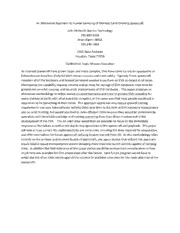
NASA Technical Reports Server (NTRS) 20110016637: An Alternative Approach to Human Servicing of Manned Earth Orbiting Spacecraft PDF
Preview NASA Technical Reports Server (NTRS) 20110016637: An Alternative Approach to Human Servicing of Manned Earth Orbiting Spacecraft
An Alternative Approach to Human Servicing of Manned Earth Orbiting Spacecraft John Mularski: Barrios Technology 281-483-5316 Brian Alpert: NASA 281-244-1964 2101 Nasa Parkway Houston, Texas 77058 Conference Topic: Mission Execution As manned spacecraft have grown larger and more complex, they have come to rely on spacewalks or Extravehicular Activities (EVA) for both mission success and crew safety. Typically these spacecraft maintain all of the hardware and trained personnel needed to perform an EVA on-board at all times. Maintaining this capability requires volume and up-mass for storage of EVA hardware, crew time for ground and on-orbit training, and on-orbit maintenance of EVA hardware . This paper proposes an alternative methodology to utilize launch-on-need hardware and crew to provide EVA capability for space stations in Earth orbit after assembly complete, in the same way that most people would call a repairman to fix something at their home. This approach would not only reduce ground training requirements and save Intravehicular Activity (IVA) crew time in the form of EVA hardware maintenance and on-orbit training, but would also lead to more efficient EVAs because they would be performed by specialists with detailed knowledge and training stemming from their direct involvement in the development of the EVA. The on-orbit crew would then be available to focus on the immediate response to the failure as well as the day-to-day operations of the spacecraft and payloads. This paper will look at how current ISS unplanned EVAs are conducted, including the time required for preparation, and offer alternatives for future spacecraft utilizing lessons learned from ISS. As this methodology relies entirely on the on-time and on-need launch of spacecraft, any space station that utilized this approach would need a robust transportation system including more than one launch vehicle capable of carrying crew. In addition the fault tolerance of the space station would be an important consideration in how much time was available for EVA preparation after the failure. Each future program would have to weigh the risk of on-time launch against the increase in available crew time for the main objective of the spacecraft.
